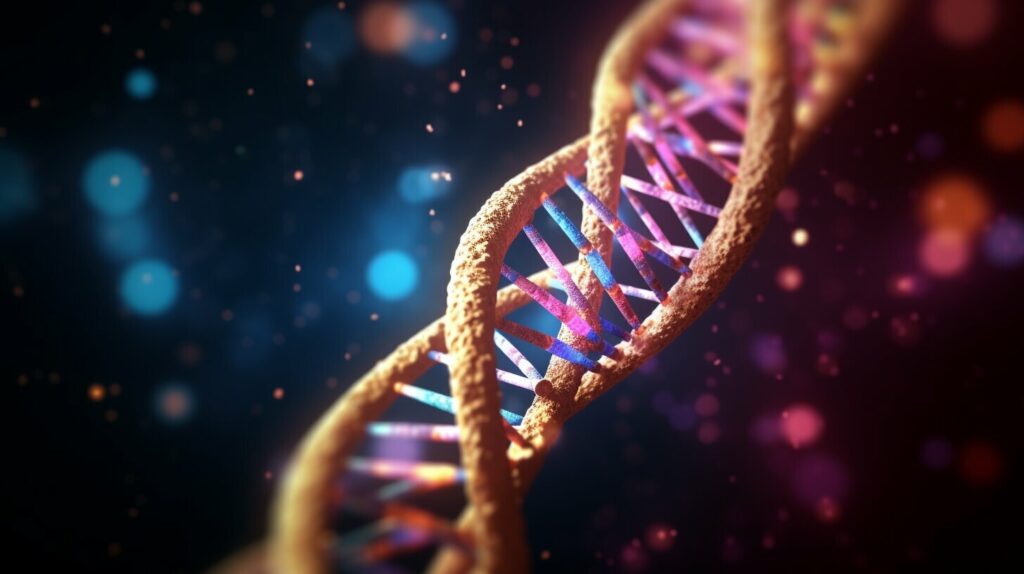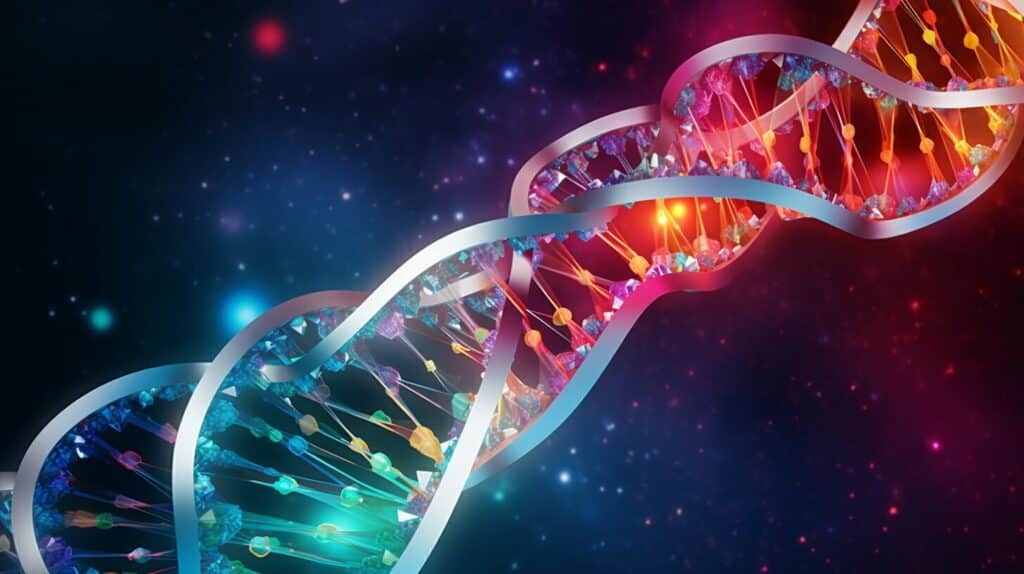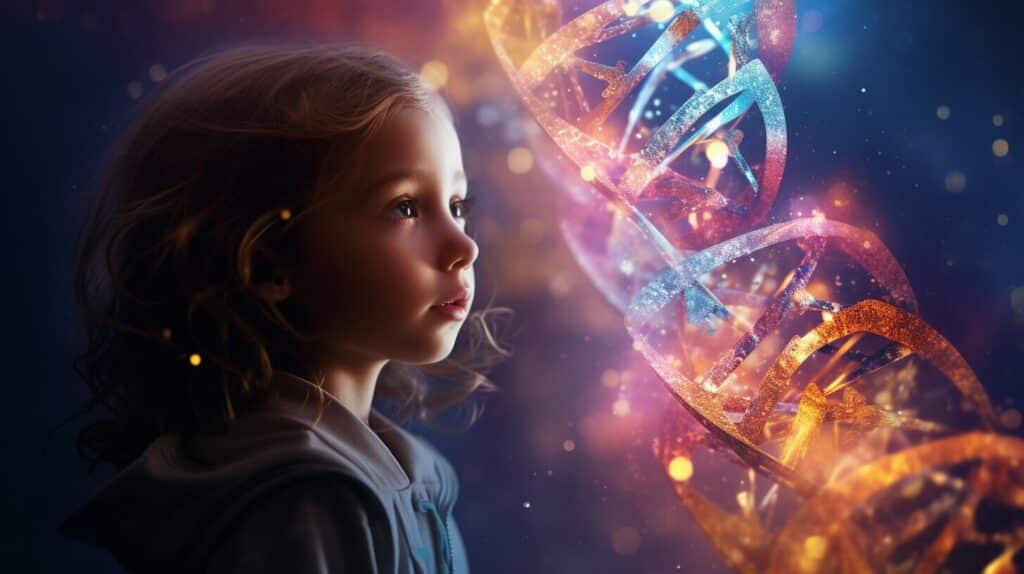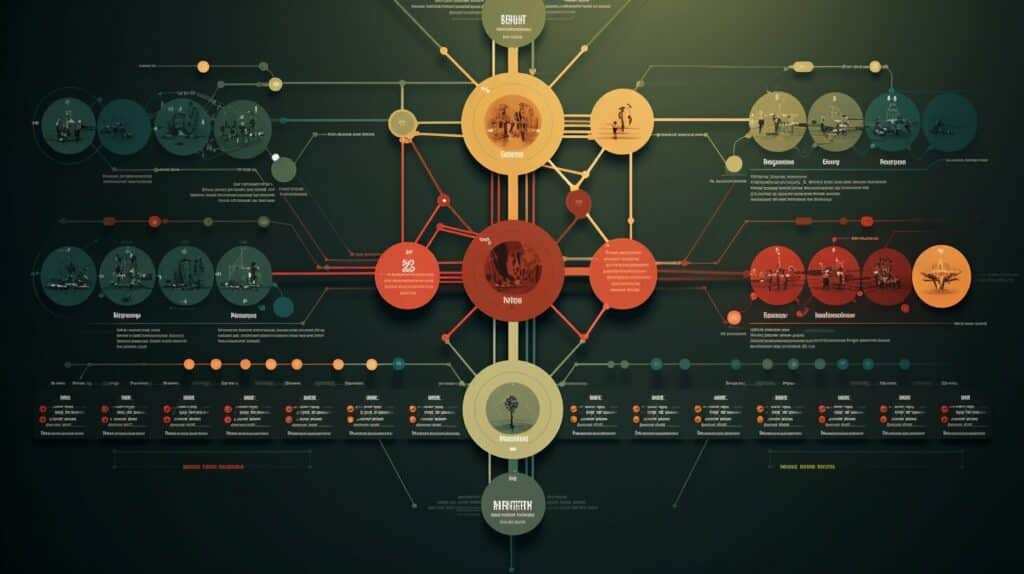As a parent, you may be surprised to see your child doesn’t resemble you or your partner in some ways. However, it’s important to understand that while children inherit traits from their parents, they are not identical to them. This is due to various genetic factors and influences that shape a child’s physical appearance and personality.
In this article, we’ll explore the basics of genetic inheritance and how it contributes to the non-identical nature of children compared to their parents. We’ll also cover more complex patterns of inheritance, discuss the role of DNA and genes, and highlight the importance of understanding the family’s genetic history. By the end, you’ll be equipped with the knowledge to explain why a child is not identical to either parent.
Key Takeaways:
- Children inherit traits from their parents, but they are not identical to either parent due to various genetic factors and influences.
- Understanding genetic inheritance, DNA, and genes is essential for explaining the non-identical nature of children.
- The family’s genetic history plays a significant role in shaping a child’s physical appearance and personality.

Understanding Genetic Inheritance
Genetic inheritance refers to the passing down of genetic traits from parents to their offspring. The traits passed down can affect physical characteristics, mental capabilities, and predisposition to certain diseases.
Genes are the basic units of inheritance and are located on chromosomes in the nucleus of cells. Each gene carries information about a specific trait, such as eye color or height.
There are two types of genes: dominant and recessive. Dominant genes are expressed even if only one copy is present, while recessive genes are only expressed if two copies are present.
For example, if one parent has blue eyes (a recessive trait) and the other parent has brown eyes (a dominant trait), their children may inherit one copy of the brown eye gene from the dominant parent and one copy of the blue eye gene from the recessive parent. In this case, the brown eye gene would be expressed, and the child would have brown eyes.
However, if both parents have blue eyes and carry two copies of the blue eye gene, their child will also inherit two copies of the blue eye gene, resulting in the child having blue eyes.
Genetic inheritance is a complex process that involves many factors, including the type of gene, the location of the gene on the chromosome, and the presence of other genes that may interact with it. Understanding these factors is crucial in explaining why a child may not be identical to either parent.

Understanding Genetic Inheritance
“Genetic inheritance refers to the passing down of genetic traits from parents to their offspring.”
These traits can be inherited from either the mother or father, and many traits are determined by the interaction of multiple genes. For example, height is influenced by the interaction of many genes, making it a complex trait to study.
There are also cases where traits may skip a generation or appear unexpectedly due to complex patterns of inheritance. These patterns can include co-dominance, where both dominant traits are expressed in the offspring, or incomplete dominance, where a combination of the two parent traits is expressed.
Overall, understanding genetic inheritance is essential in explaining why children may not be identical to either parent, and it can provide insight into the various factors that influence a child’s physical and mental characteristics.
Genetic Variation and Family Traits
It’s important to understand that genetic variation is what makes each child unique, even if they come from the same parents. Traits such as eye color, hair texture, and height can vary greatly between siblings. This is because each child inherits a different combination of genes from their parents.
Genetic variation occurs due to many factors, including dominant and recessive genes, random genetic mutations, and environmental influences. It’s important to note that even within the same family, children can have different genetic expressions of traits.
| Family Member | Eye Color | Hair Texture | Height |
|---|---|---|---|
| You | Brown | Straight | 5’8″ |
| Your Sister | Green | Curly | 5’4″ |
| Your Brother | Blue | Straight | 6’2″ |
As you can see from the table above, even siblings can have vastly different appearances and physical characteristics, despite sharing the same parents. This is because each child inherits a unique combination of genes from their parents, resulting in individual genetic expressions.
It’s also important to consider the influence of family genetic history on traits. Traits can skip generations and appear unexpectedly in children due to the passing down of genes from previous generations. This adds to the genetic diversity within families and contributes to the non-identical nature of children compared to their parents.

Genetic variation is what makes each of us unique and special. Embrace and celebrate the differences in your child, and appreciate the beauty of genetic diversity. By understanding the science behind genetic inheritance and variation, you can better explain to your child why they are not identical to either parent and help them appreciate their individuality.
Factors Influencing Genetic Expression
While genetics play a significant role in determining a child’s traits, there are also a variety of factors that can influence how those traits are expressed. Here are a few examples:
| Environmental Factors | Exposure to certain environmental factors can impact gene expression. For example, studies have shown that children who are exposed to cigarette smoke in the womb may be more likely to develop asthma later in life. |
|---|---|
| Epigenetics | Epigenetics refers to changes in gene expression that occur without changes to the underlying DNA sequence. These changes can be influenced by factors such as diet, stress, and other environmental factors. |
| Other Influences | Nutrition, exercise, and exposure to certain substances can also impact gene expression. For example, a child who grows up in an environment with limited access to healthy foods may be more likely to develop obesity later in life. |
Additionally, it’s important to note that not all genes are expressed equally. Some genes may be dominant, while others are recessive. This means that even if a child inherits a certain gene from their parent, it may not necessarily be expressed in the same way.
In short, genetics are just one piece of the puzzle when it comes to determining a child’s traits. Environmental factors, epigenetics, and other influences can all impact gene expression and contribute to the unique characteristics that make each child an individual.
 Genetic Expression can be influenced by various Environmental Factors
Genetic Expression can be influenced by various Environmental Factors
Role of DNA and Genes
Understanding the role of DNA and genes is essential in explaining why a child may not be identical to either parent. Genes are segments of DNA that determine specific traits, such as eye color or hair texture. Each person has two copies of each gene, one from each parent.
Some genes are dominant, meaning only one copy is needed to express the trait, while others are recessive, requiring two copies to manifest. For example, if one parent has a dominant brown eye gene and the other has a recessive blue eye gene, the child may inherit the brown eye gene and have brown eyes, since it is dominant.
Other genes, such as those determining height and intelligence, are more complex and involve the interaction of multiple genes. Researchers have identified over 20,000 genes in the human genome, each playing a role in shaping an individual’s physical and cognitive characteristics.
In addition to inherited genes, new mutations can occur spontaneously, leading to the development of unique traits in offspring. These mutations can be beneficial, harmful, or have no impact on the individual.

It’s important to note that while genes provide the blueprint for an individual’s development, environmental factors can also play a significant role. For instance, a person’s height may be influenced by factors such as nutrition and exercise, in addition to genetic factors.
In the next section, we’ll explore how genetic mutations can contribute to new traits in offspring.
Genetic Mutations and New Traits
While genetic traits are typically inherited from parents, mutations can occur that result in new and unique traits in offspring. These mutations can arise spontaneously, or they can be influenced by environmental factors such as radiation or exposure to certain chemicals.
One example of a genetic mutation leading to a new trait is the development of lactose tolerance in humans. Historically, most humans were unable to digest lactose in milk past infancy. However, a genetic mutation occurred in some populations that allowed them to continue to produce lactase, the enzyme needed to digest lactose, throughout their lives. This mutation allowed for the consumption of dairy products and a new food source for those with the mutation.
It’s important to note that not all genetic mutations lead to desirable or advantageous traits. In some cases, mutations can lead to genetic disorders or diseases. However, understanding the possibility of mutations and their potential for new traits can provide insight into the diversity seen in offspring.

Complex Inheritance Patterns
While dominant and recessive genes are the most well-known inheritance patterns, there are more complex patterns that can influence the physical traits of a child. One example of this is polygenic inheritance, where multiple genes contribute to a single trait, such as height or skin color.
Co-dominance is another complex inheritance pattern where both alleles are expressed equally, resulting in a unique physical trait. For example, if a parent with type A blood and a parent with type B blood have a child with AB blood, this is an example of co-dominance.
Additionally, epigenetics can also play a role in complex inheritance patterns. Environmental factors, such as diet or stress, can modify gene expression without changing the underlying DNA sequence. This can result in variations in physical traits between siblings with the same genetic makeup.
Understanding these complex inheritance patterns is important in explaining why a child may not be identical to either parent. It highlights the diversity of genetic factors that contribute to an individual’s physical attributes.

Other Influences on Appearance and Traits
While genetic factors play a significant role in determining a child’s traits, it’s essential to recognize that other external factors can also influence their appearance.
Nutrition: What you eat during pregnancy affects your baby’s development. A balanced diet rich in vitamins and minerals can promote healthy growth and development, while a diet lacking in essential nutrients can lead to developmental problems.
Exercise: Exercise during pregnancy can result in a healthier baby, as it can increase blood flow and oxygenation to the fetus, promoting healthy growth and development.
Exposure to Substances: Exposure to toxins, chemicals, or medications during pregnancy can lead to birth defects or developmental delays. It is important to consult with a healthcare provider before taking any medication or being exposed to specific substances during pregnancy.
The Image Below:

“Both genetic and non-genetic factors interact to influence childhood growth and development” – World Health Organization
As you can see, genetic factors are just one piece of the puzzle in determining your child’s characteristics. Taking care of yourself during pregnancy and being mindful of your child’s environment can promote healthy growth and development, leading to a happy and healthy baby.
Family Genetic History
Understanding your family’s genetic history can provide insight into why your child may not be identical to either parent. Traits from previous generations can manifest in unexpected ways, adding to the genetic diversity of offspring.
Ask your family members about any genetic conditions or traits that seem to run in the family. This can include physical characteristics like eye color or hair texture, as well as medical conditions like heart disease or diabetes.
Knowing your family’s genetic history can also help you make informed decisions about your child’s health. If certain conditions or traits are common in your family, you can take steps to prevent or manage them.
It’s important to note that genetic testing can also provide valuable information about your family’s genetic history. Talk to your doctor about genetic testing options and whether they may be appropriate for your family.
Remember, understanding your family’s genetic history can help you better understand and appreciate your child’s unique traits.

Emphasizing Individuality and Acceptance
It’s important to remember that every child is unique and has their own individual traits and characteristics. While it’s natural to compare them to their parents, it’s essential to embrace and celebrate their differences and genetic diversity.
Encouraging your child to be confident in their individuality can help foster self-acceptance and appreciation for their unique traits and talents. Celebrate their accomplishments, whether it’s a perfect score on a test or a new skill they’ve learned.

“Individuality is the salt of common life. You cannot have too much of it.”
Exposing your child to diversity can also help them appreciate and accept differences in others. Encourage them to make friends with kids from different backgrounds, cultures, and ethnicities. This will also help build their social skills and broaden their horizons.
Remember, genetics is just one aspect of what makes your child who they are. By embracing their unique traits and fostering a positive attitude towards diversity, you can help your child grow into a confident, accepting, and well-rounded individual.
Conclusion
Now that you understand the various genetic factors and influences that contribute to a child’s non-identical nature compared to their parents, it’s important to celebrate and accept each child’s individuality. Remember that genetic diversity is a beautiful thing and can lead to unique talents, strengths, and characteristics.
Continue to foster a positive and accepting attitude towards genetic differences in children, and don’t be afraid to embrace their quirks and differences. By doing so, you’ll help your child develop a strong sense of self-acceptance and appreciation for their own unique traits.

How Can I Use the Explanation of Marriage to Help My Child Understand Why They Don’t Look Like Either Parent?
When it comes to explaining marriage to a child and addressing why they don’t resemble either parent, here are a few tips for parents. Begin by emphasizing love, commitment, and the unique combination of traits parents provide. Encourage open conversations, assuring them that appearance doesn’t define familial bonds. Lastly, highlight the beauty in diversity to help them embrace their own uniqueness. Tips for explaining marriage to a child can lay a foundation for understanding and acceptance.
FAQ
Q: How do genes contribute to a child’s traits?
A: Genes are inherited from both parents and determine various traits, such as eye color, hair texture, and height. However, children are not identical to their parents due to genetic variation.
Q: What factors influence genetic expression in children?
A: Genetic expression can be influenced by environmental factors, epigenetics, and other influences. These factors can impact how inherited traits are manifested in children.
Q: Can genetic mutations lead to the development of new traits?
A: Yes, genetic mutations can occur and result in unique characteristics not found in either parent. These mutations contribute to the diversity seen in offspring.
Q: Do complex inheritance patterns contribute to the non-identical nature of children?
A: Yes, complex patterns of inheritance, such as polygenic traits and co-dominance, can contribute to the non-identical nature of children compared to their parents.
Q: What other influences can affect a child’s appearance and traits?
A: Factors such as nutrition, exercise, and exposure to certain substances can also influence a child’s appearance and traits, in addition to genetic factors.
Q: How does understanding family genetic history help explain differences between parents and children?
A: Understanding the family’s genetic history can provide insights into why a child may not be identical to either parent. Traits from previous generations can manifest in unexpected ways, adding to the genetic diversity of offspring.
Q: Why is it important to celebrate a child’s individuality and genetic diversity?
A: Embracing a child’s unique traits and talents fosters self-acceptance and appreciation for genetic diversity. Each child is special and should be celebrated for their individuality.






